Deformation Property and Suppression of Ultra-Thin-Walled Rectangular Tube in Rotary Draw Bending
Abstract
1. Introduction
2. Materials and Methods
2.1. Workpiece
2.2. Bend Radius
2.3. Rotary Draw Bending System
2.4. Mandrel
2.5. Finite Element Analysis (FEA) Model
3. Results and Discussion
3.1. The Mechanism of Cross-Sectional Deformation
3.2. Method for Evaluating Deformation
3.3. Effect of the Laminated Mandrel and Axial Tension
- Axial tension
- 1/R
- Cross-section outline
- Thickness
- Work-hardening exponent
- Plastic modulus (Young’s modulus)
3.4. Effect of Restraint Jig
3.5. Effect of the Bumpy Laminated Elastic Mandrel
4. Conclusions
- The component flattening forces PTN and the distributed flattening force wTN increase as bending degree ρ (bending radius R), thickness t0, height H0, and axial tension Pa increase.
- Wrinkling tended to occur when bending an ultra-thin wall tube. However, wrinkling can be suppressed by applying axial tension.
- By applying the mandrel to a tube with R/H0 = 1.5 (H0 = 20, R = 50), it was possible to suppress cross-sectional deformation in the height direction. In contrast, pear-shaped deformation peculiar to ultra-thin wall tube occurred.
- The pear-shaped deformation could be suppressed to Wmin = −4%, Wmax = 1% by restraining the side surface of the ultra-thin wall tube with H0 = 10, R = 20. In contrast, wrinkling and waveform deformation such as a long column buckling phenomenon occurred on the web of the tube with H0 = 20, R = 50, h = 20.
- By adjusting and stepping the clearance in the width direction of the mandrel on the tension side and the compression side of the ultra-thin wall tube with R/H0 = 1.5 (H0 = 20, R = 50, h = 20), along with the restraint on the side surface and the axial force, it was possible to suppress to H = 1%, Wmax = 3%, and Wmin = −7%. Namely, it was possible to suppress the pear-shaped deformation peculiar to ultra-thin wall tube and waveform deformation such as a long column buckling phenomenon.
- It was found that the deformation of the cross-section peculiar to the ultra-thin rectangular tube can be suppressed by applying axial tension, applying side restraint (h = 20), and adjusting the widthwise clearance of the mandrel on the compression and the tension sides of the tube (CLh = 0 mm, CLw = 1.0 mm/0.5 mm).
Author Contributions
Funding
Acknowledgments
Conflicts of Interest
References
- Takahashi, K.; Murata, M. Trend of tubular bending. J. JPN Light Met. 2006, 56, 283–289. [Google Scholar] [CrossRef]
- Utsumi, N.; Sakaki, S. Countermeasures against undesirable phenomena in the draw-bending process for extruded square tubes. J. Mater. Process. Technol. 2002, 123, 264–269. [Google Scholar] [CrossRef]
- Fuchs, F.J., Jr. Waveguide Bending Design Analysis: Theory of Bending and Formulae for Determination of Wall Thicknesses. Bell Syst. Tech. J. 1959, 38, 1457–1484. [Google Scholar] [CrossRef]
- Gu, R.J.; Yang, H.; Zhan, M.; Li, H.; Li, H.W. Research on the springback of thin-walled tube NC bending based on the numerical simulation of the whole process. Comput. Mater. Sci. 2008, 42, 537–549. [Google Scholar] [CrossRef]
- Zhang, H.; Liu, Y.; Liu, C. Multi-Objective Parameter Optimization for Cross-Sectional Deformation of Double-Ridged Rectangular Tube in Rotary Draw Bending by Using Response Surface Methodology and NSGA-II. Metals 2017, 7, 206. [Google Scholar] [CrossRef]
- Strano, M. Automatic tooling design for rotary draw bending of tubes. Int. J. Adv. Manuf. Technol. 2005, 26, 733–740. [Google Scholar] [CrossRef]
- Sherif, S.S.; Mostafa, S.; Mohammad, M.M. Limit load analysis of thin-walled as-fabricated pipe bends with low ovality under in-plane moment loading and internal pressure. Thin Walled Struct. 2019, 114, 106336. [Google Scholar]
- Gantnerl, P.; Harrison, D.K.; De Silva, A.K.; Bauer, H. The Development of a Simulation Model and the Determination of the Die Control Data for the Free-Bending Technique. Proc. Inst. Mech. Eng. Part B J. Eng. Manuf. 2007, 221, 163–171. [Google Scholar] [CrossRef]
- Masoumi, H.; Mirbagheri, Y. Effect of Mandrel, Its Clearance and Pressure Die on Tube Bending Process via Rotary Draw Bending Method. Int. J. Adv. Des. Manuf. Technol. 2012, 5, 47–52. [Google Scholar]
- Hassan, H.R.; Abdulgaffar, S.M.; Mohsen, K.K.; Egab, K. Investigation of Material Properties Effect on the Ovalization Phenomenon in the Tube Bending Produced by RDB. IOP Conf. Ser. Mater. Sci. Eng. 2020, 671, 012010. [Google Scholar] [CrossRef]
- Kourosh, H.; Mahmoud, B.; Behnaz, A.; Mehrdad, P. The effect of anisotropy on wrinkling of tube under rotary draw bending. J. Mech. Sci. Technol. 2013, 27, 783–792. [Google Scholar]
- Xin, X.; Juan, L.; Gabriela, V.; Jose, G. Twist springback of asymmetric thin-walled tube in mandrel rotary draw bending process. Procedia Eng. 2014, 81, 2177–2183. [Google Scholar]
- Christopher, H.; Rainer, S.; Bernd, E. Rotary-draw-bending using tools with reduced geometries. Procedia Manuf. 2018, 15, 804–811. [Google Scholar]
- Linda, B.; Christopher, K.; Peter, F.; Bernd, E. Sensitivity analysis of the rotary draw bending process as a database of digital equipping support. Procedia Manuf. 2019, 29, 592–599. [Google Scholar]
- Yang, H.; Li, H.; Zhan, M. Friction role in bending behaviors of thin-walled tube in rotary-draw-bending under small bending radii. J. Mater. Process. Technol. 2010, 210, 2273–2284. [Google Scholar] [CrossRef]
- Muresan, C.; Achimas, G. Numeric Simulation of Material Behavior in Mandrel Bending. Appl. Math. Mech. Eng. 2014, 57, 455–460. [Google Scholar]
- Mohammad, S.; Mahmoud, F.; Mahmoud, K.; Mohsen, N. A chain link mandrel for rotary draw bending: Experimental and finite element study of operation. Int. J. Adv. Manuf. Technol. 2015, 79, 1071–1080. [Google Scholar]
- Kami, A.; Dariani, B.M. Prediction of wrinkling in thin-walled tube push-bending process using artificial neural network and finite element method. Proc. Inst. Mech. Eng. Part B J. Eng. Manuf. 2011, 225, 1801–1812. [Google Scholar] [CrossRef]
- Lucian, L. Effect of internal fluid pressure on quality of aluminum alloy tube in rotary draw bending. Int. J. Adv. Manuf. Technol. 2013, 64, 85–91. [Google Scholar]
- Kajikawa, S.; Wang, G.; Kuboki, T.; Watanabe, M.; Tsuichiya, A. Prevention of defects by optimizing mandrel position and shape in rotary draw bending of copper tube with thin wall. Procedia Manuf. 2018, 15, 828–835. [Google Scholar] [CrossRef]
- Fang, J.; Lu, S.; Liang, C.; Ceng, L.; Zheng, D. Influences of mandrel types on forming quality of TA18 high strength tube in numerical control bending. IOP Conf. Ser. Mater. Sci. Eng. 2019, 631, 032032. [Google Scholar] [CrossRef]
- Zhang, Z.; Yang, H.; Li, H.; Ren, N.; Tian, Y. Bending behaviors of large diameter thin-walled CP-Ti tube in rotary draw bending. Prog. Nat. Sci. Mater. Int. 2011, 21, 401–412. [Google Scholar] [CrossRef]
- Fang, J.; Lu, S.; Wang, K.; Xu, J.; Xu, X.; Yao, Z. Effect of Mandrel on Cross-Section Quality in Numerical Control Bending Process of Stainless Steel 2169 Small Diameter Tube. Adv. Mater. Sci. Eng. 2013, 2013, 1–9. [Google Scholar] [CrossRef]
- Frode, P.; Torgeir, W. Cross-sectional deformations of rectangular hollow sections in bending: Part I–experiments. Int. J. Mech. Sci. 2001, 43, 109–129. [Google Scholar]
- Hong, Z.; Yuli, L.; Honglie, Z. Study on cross-sectional deformation of rectangular waveguide tube with different materials in rotary draw bending. J. Mater. Res. 2017, 32, 3912–3920. [Google Scholar]
- Nakajima, K.; Utsumi, N.; Yoshida, M. Suppressing method of the cross-section deformation for extruded square tubes in press bending. Int. J. Precis. Eng. Manuf. 2013, 14, 965–970. [Google Scholar] [CrossRef]
- Utsumi, N.; Saito, Y.; Yoshida, M. Effects of axial tension in rotary draw bending of thin-walled rectangular aluminum alloy tubes. In Proceedings of the 69th Japanese Joint Conference for the Technology of Plasticity, Kumamoto, Japan, 27–28 October 2018. [Google Scholar]
- Saito, Y.; Kono, Y.; Kamimura, T.; Utsumi, N.; Yoshida, M. Deformation of property and working limit of thin-walled rectangular tube in rotary draw bending. In Proceedings of the 5th Asian Symposium on Materials and Processing, Bangkok, Thailand, 7–8 December 2018. [Google Scholar]
- Sakaki, S.; Utsumi, N. Deformation property and working limit of extruded square sections in rotary-bending process. Adv. Technol. Plast. 2002, 2, 1763–1768. [Google Scholar]

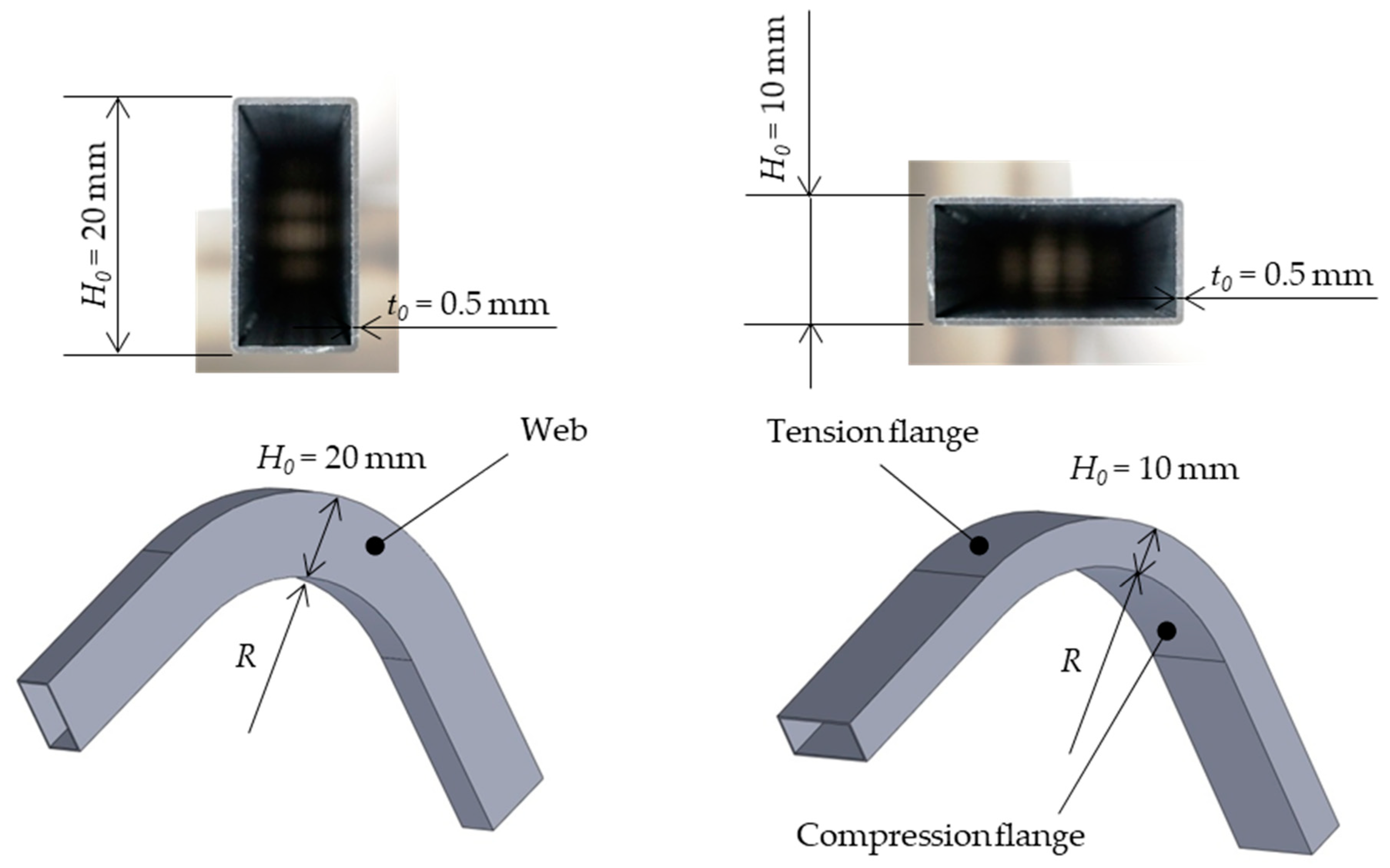
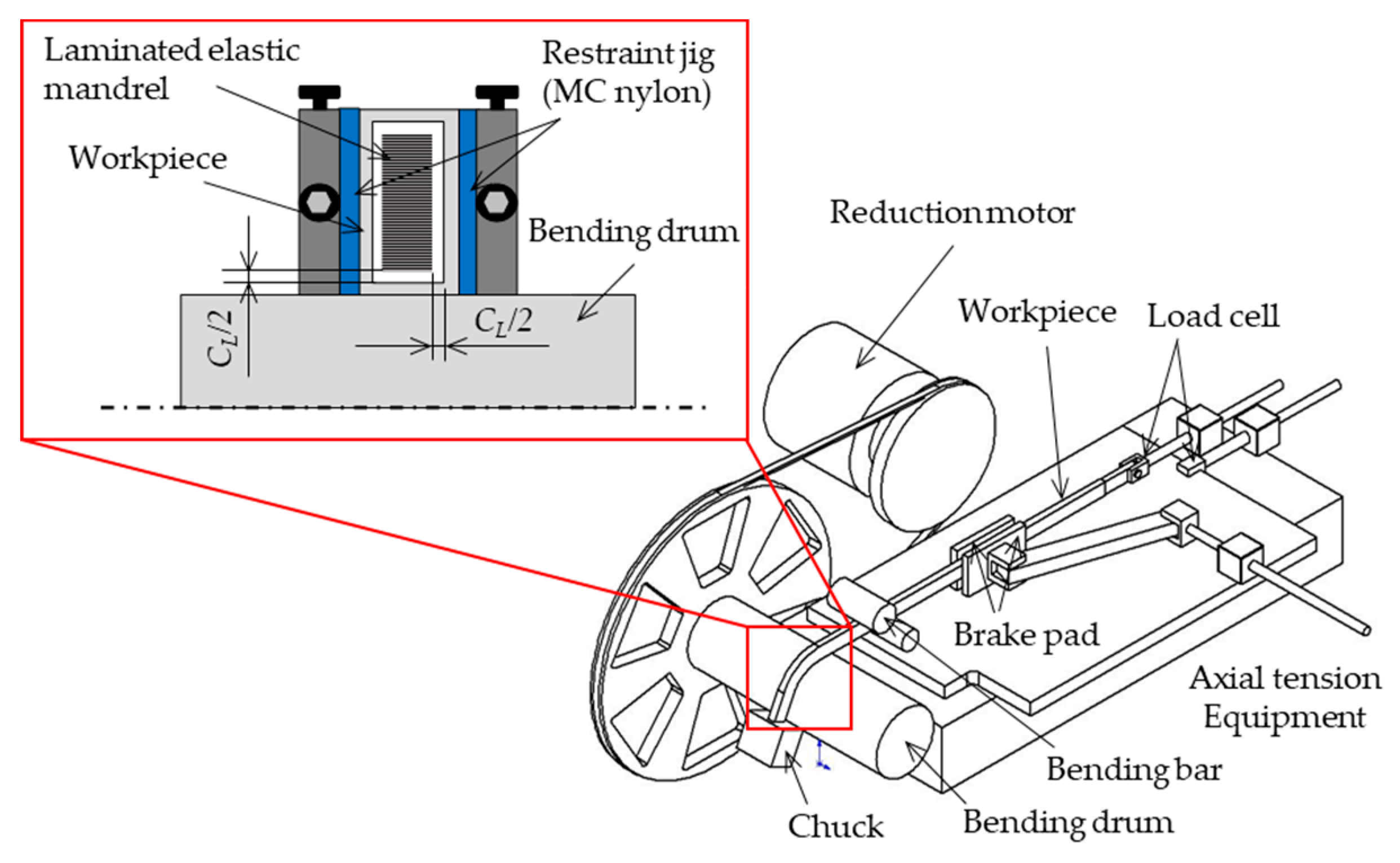
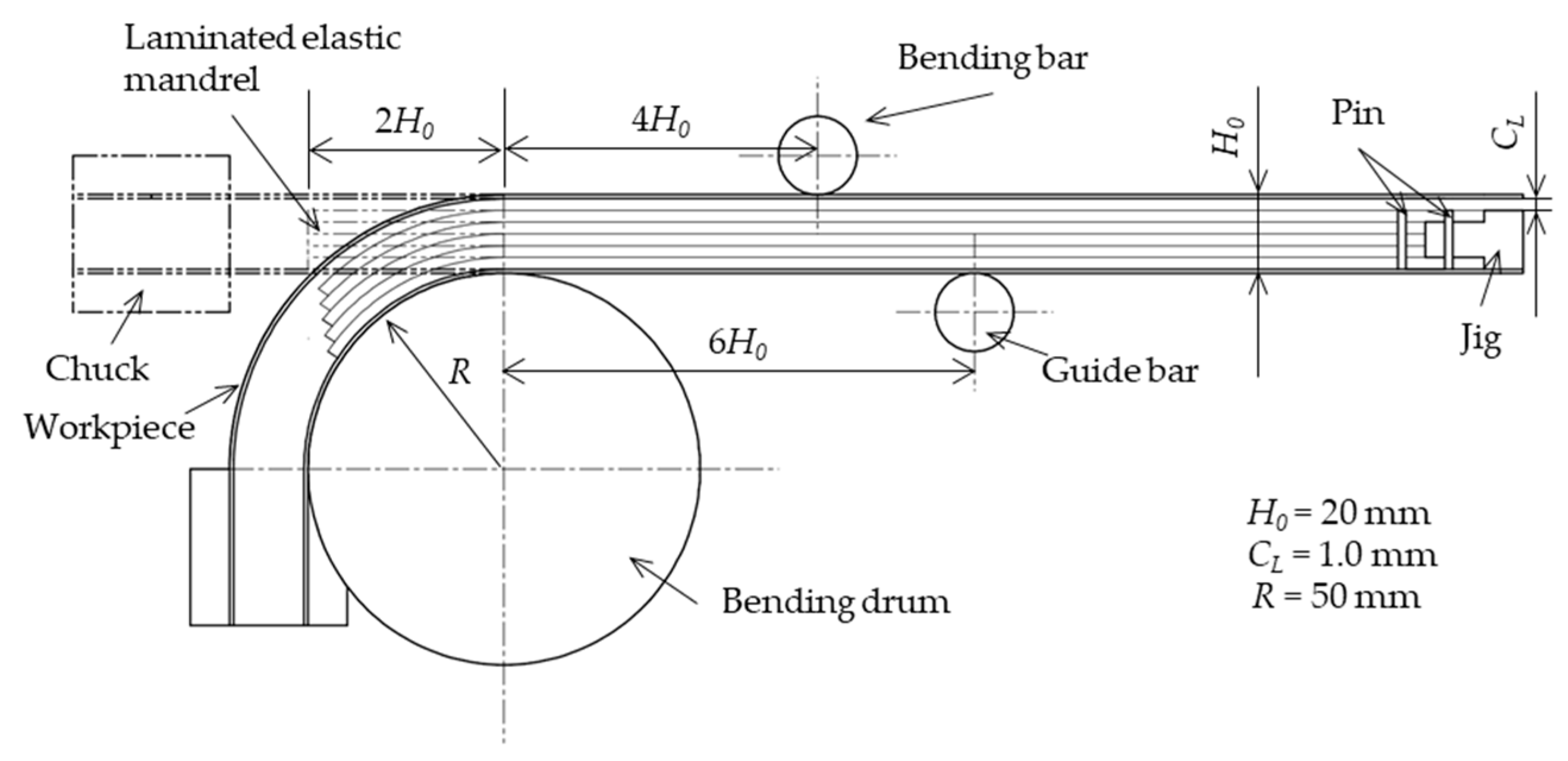

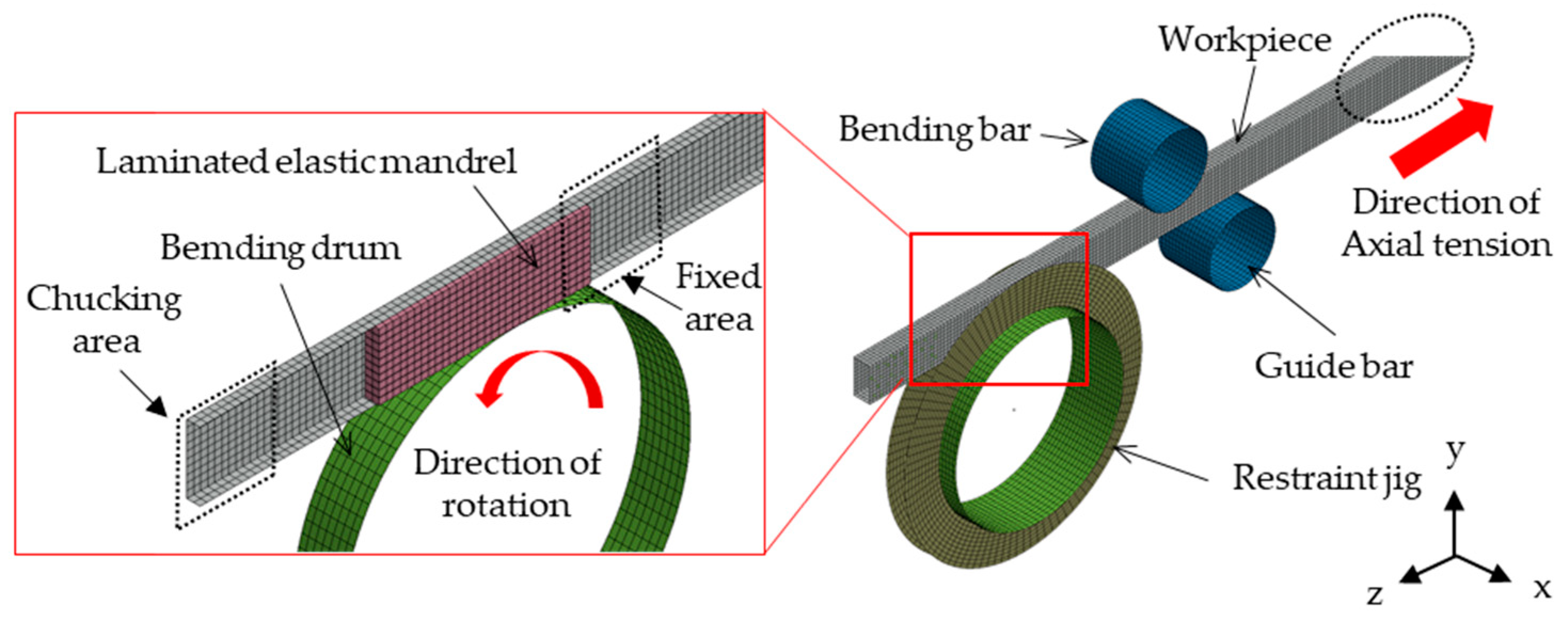
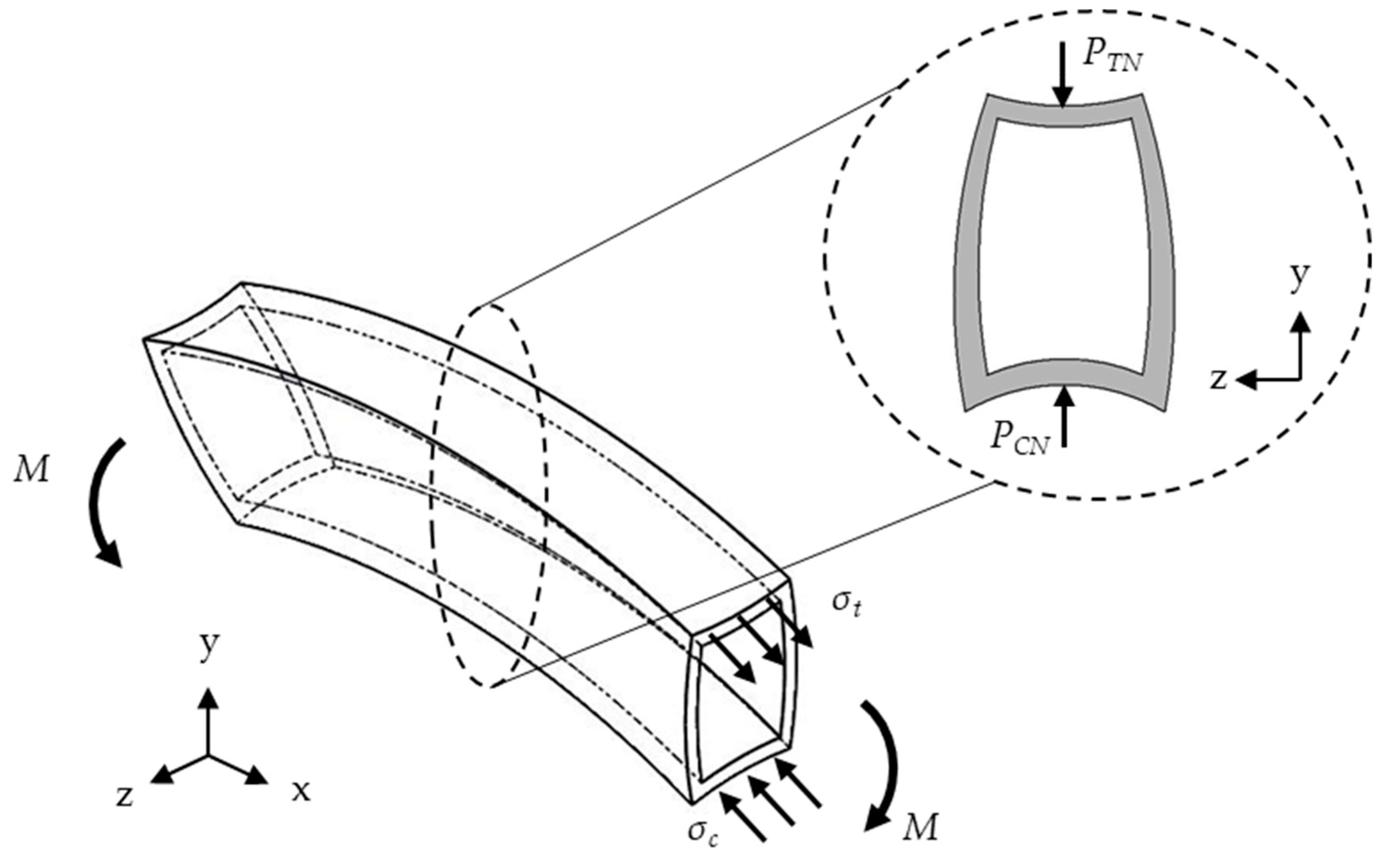
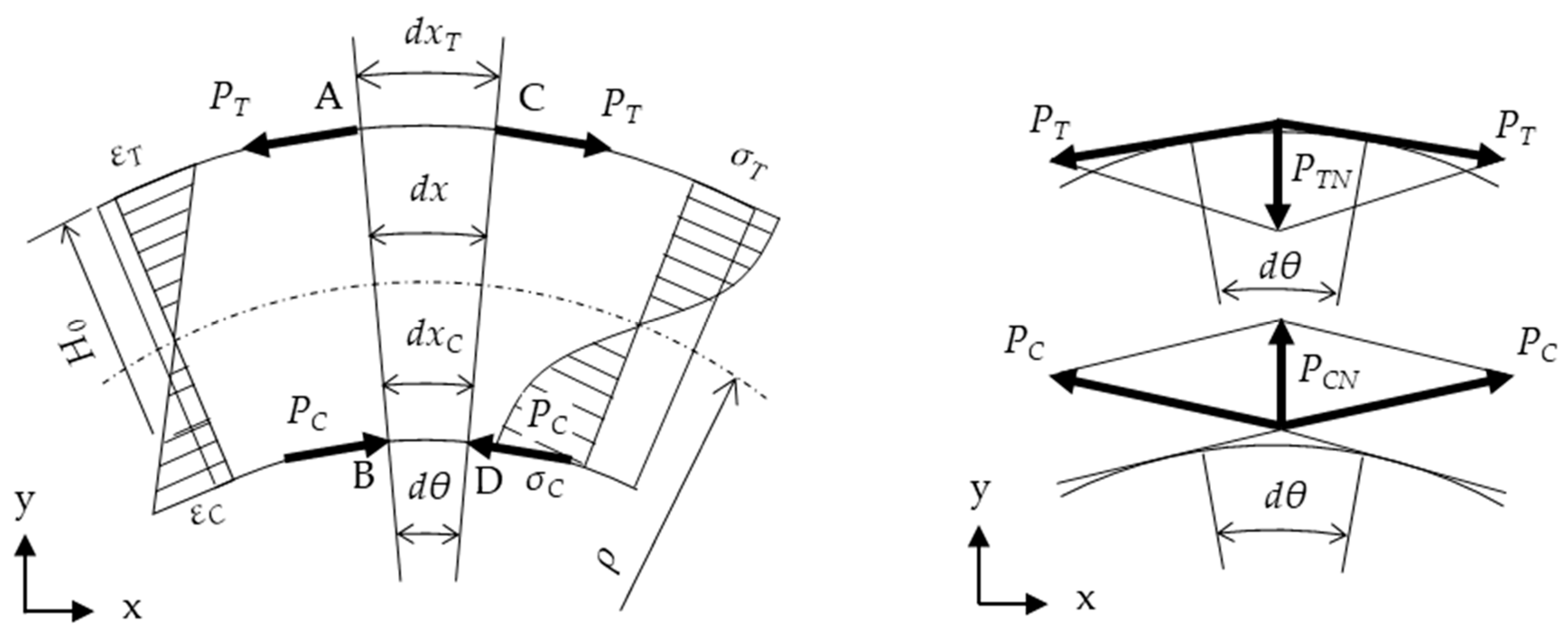

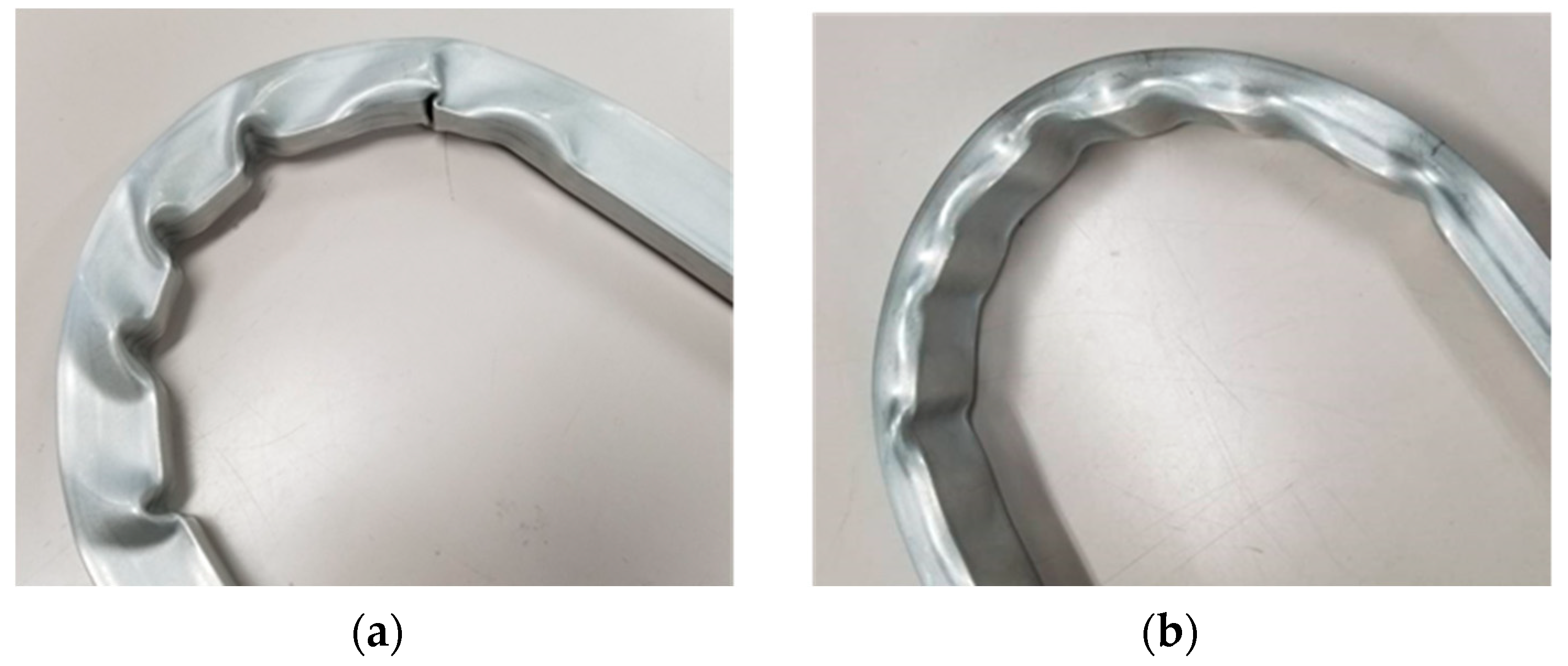
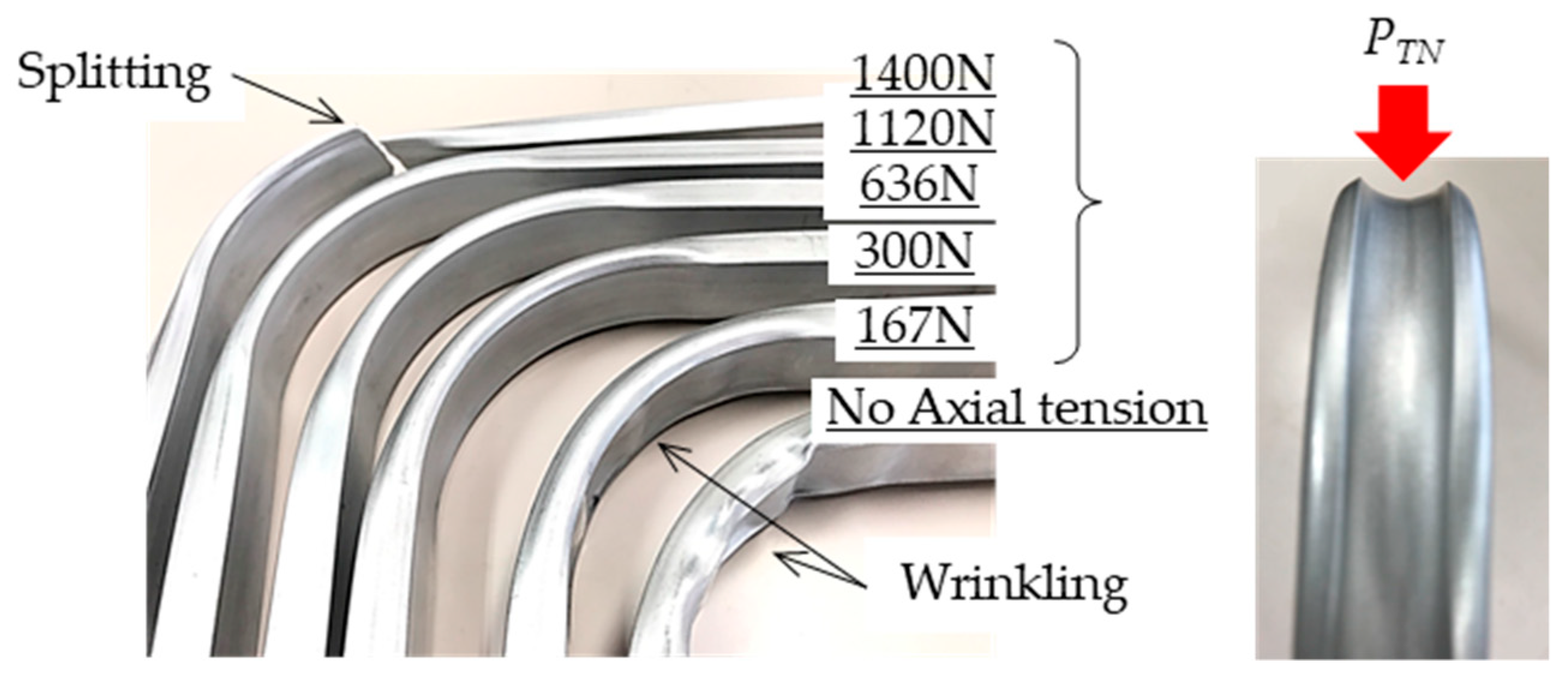
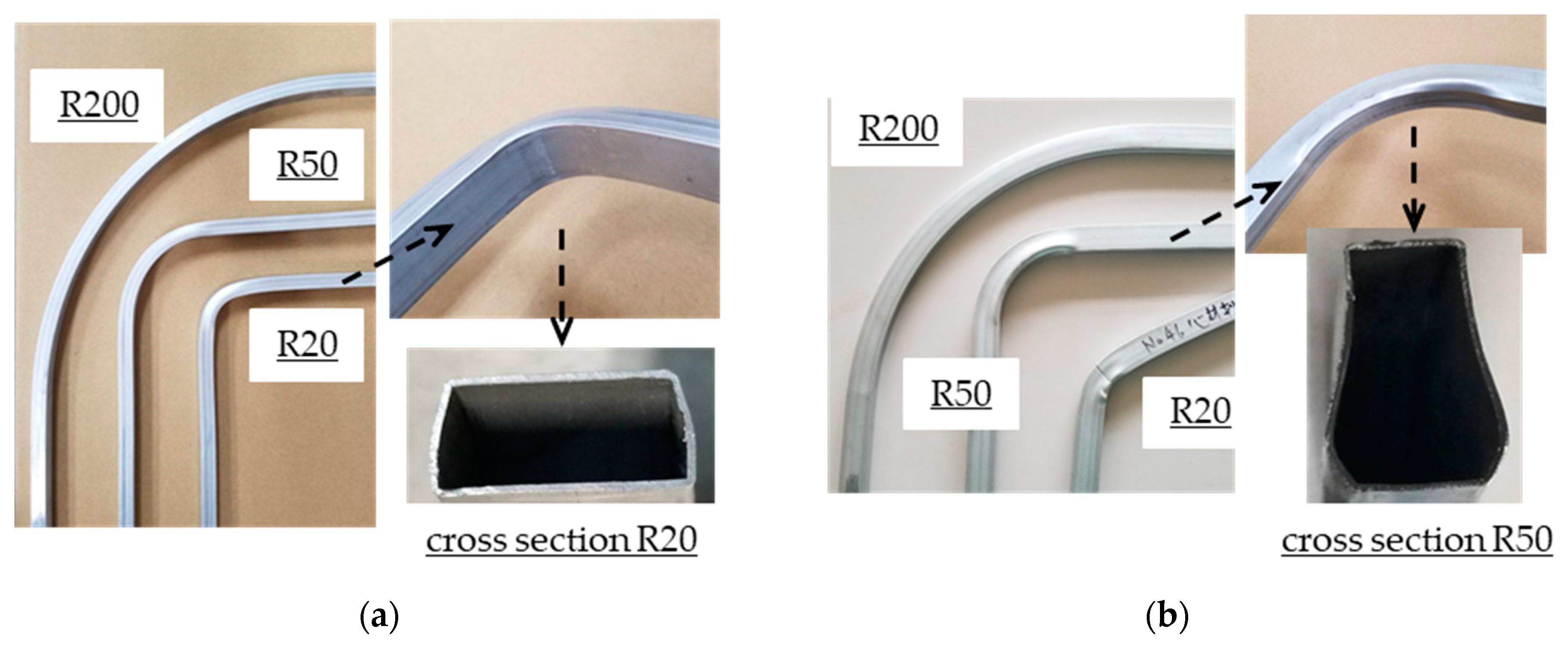
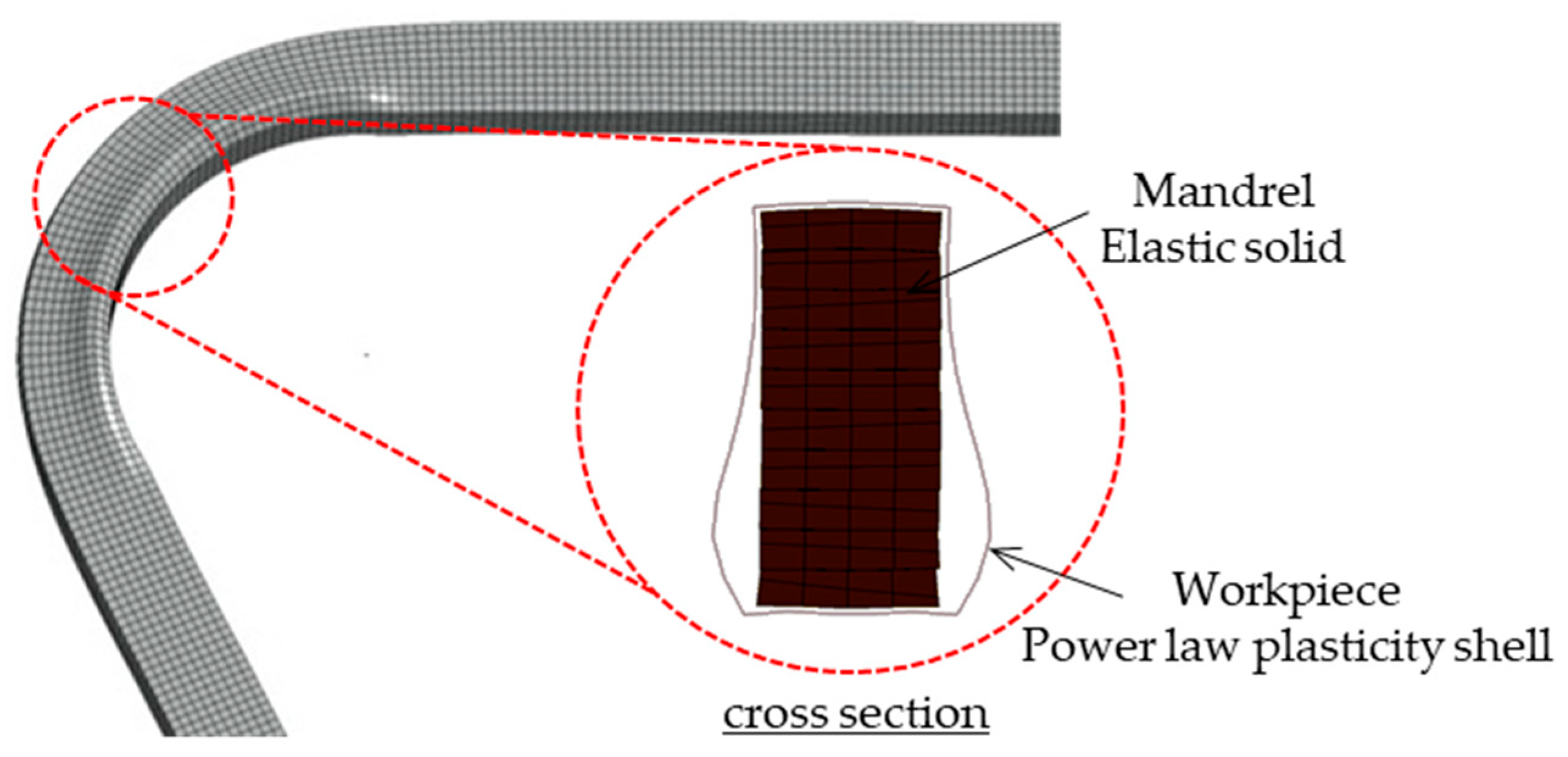
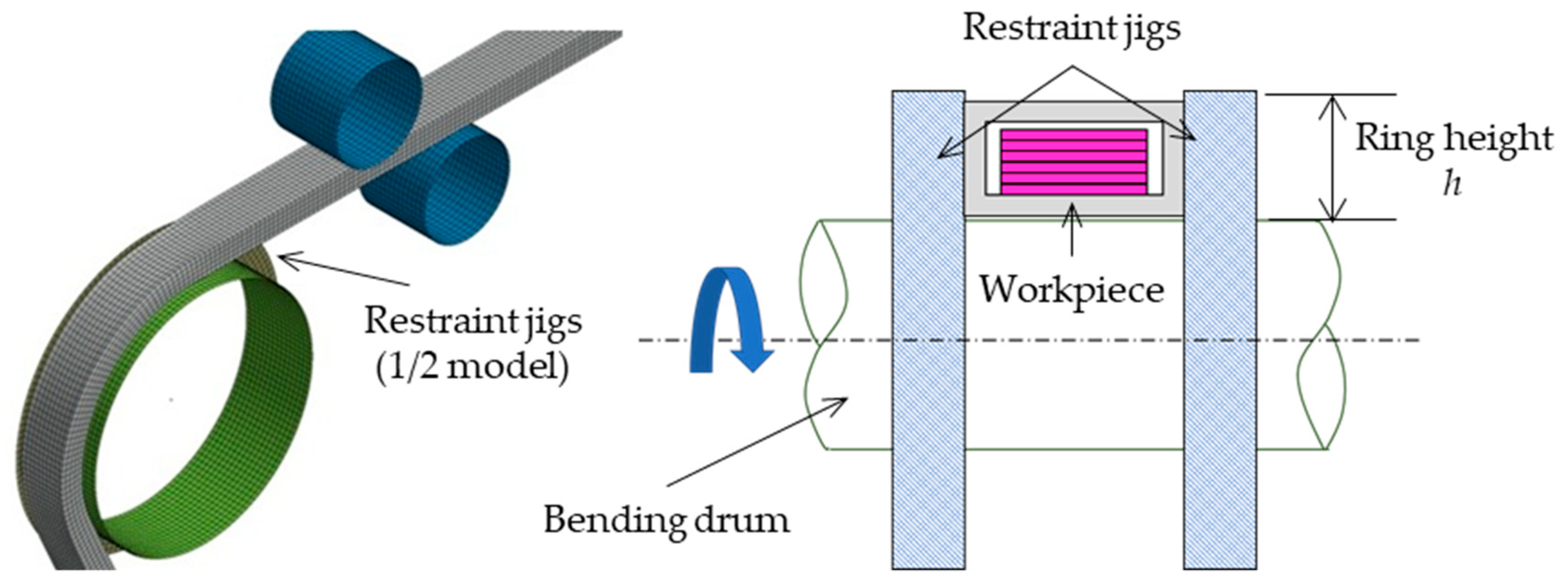

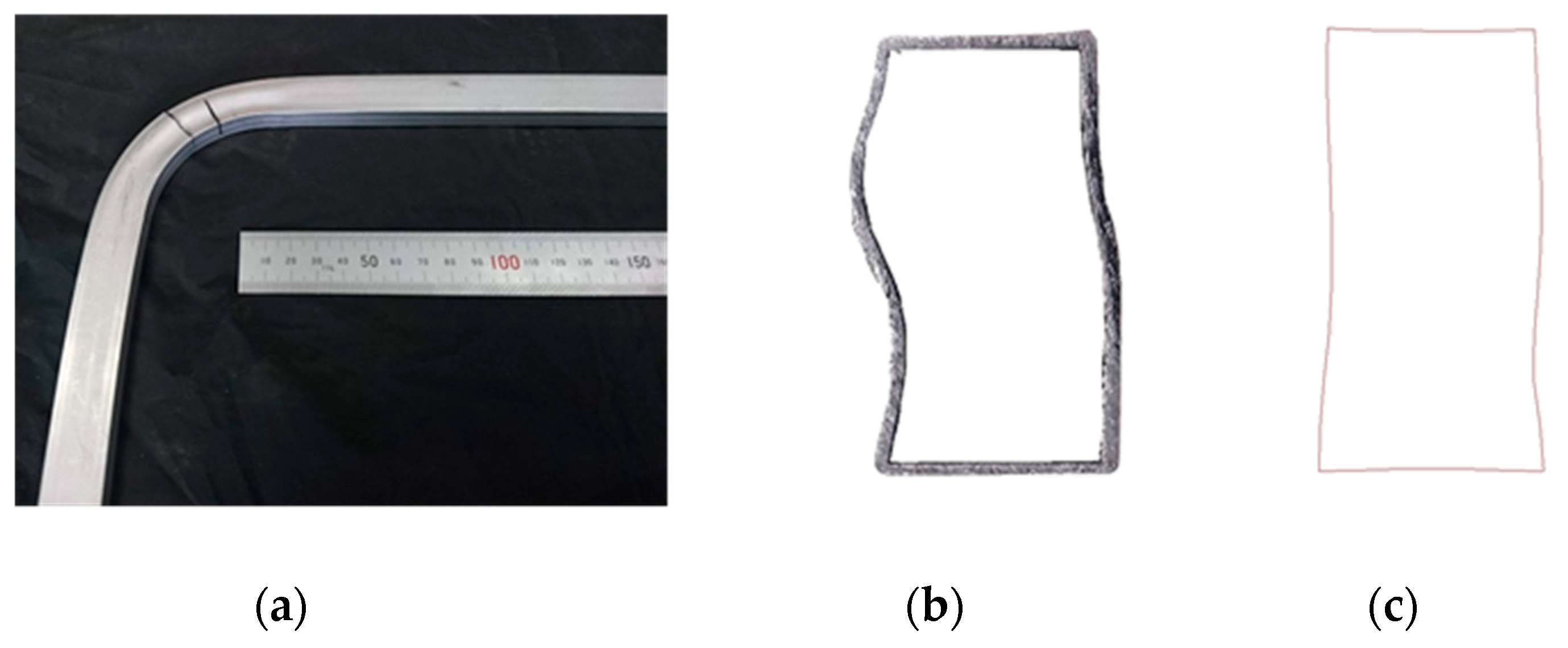
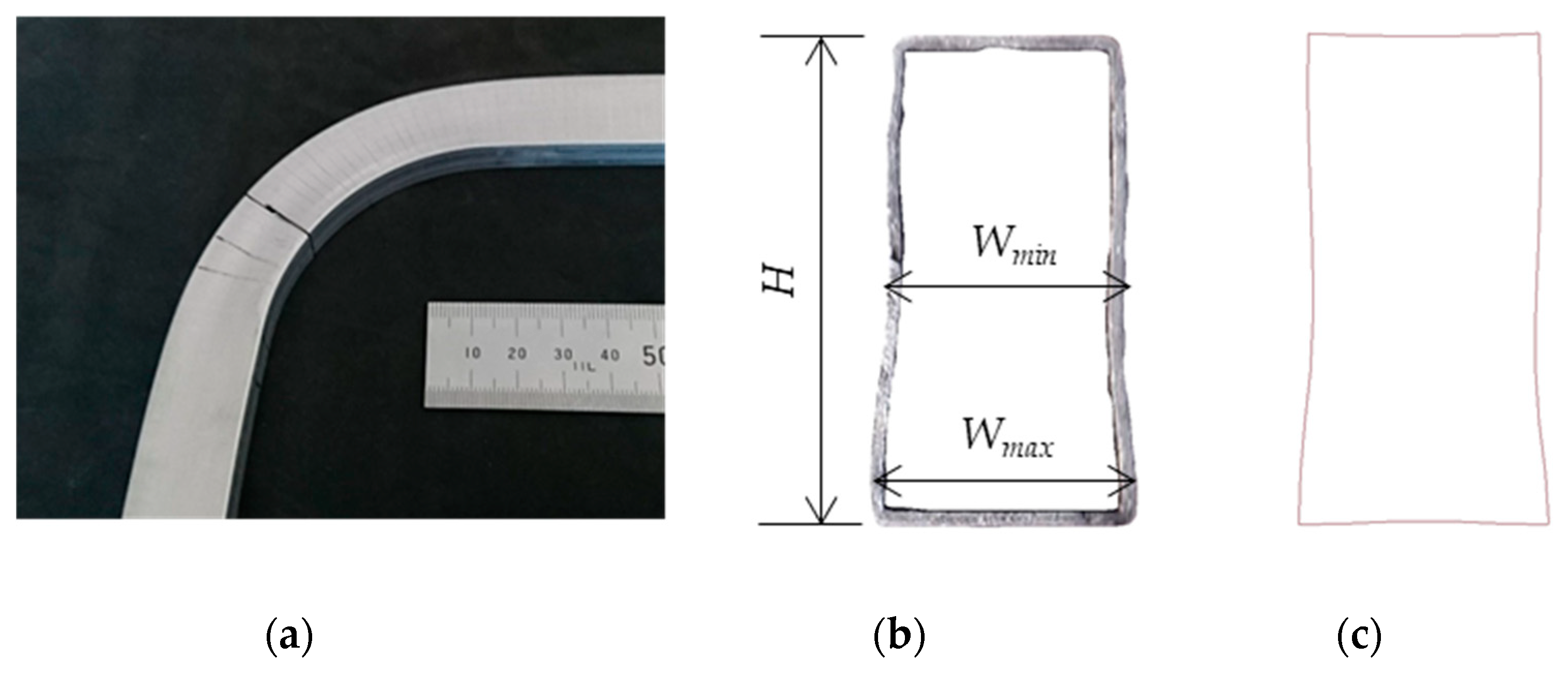
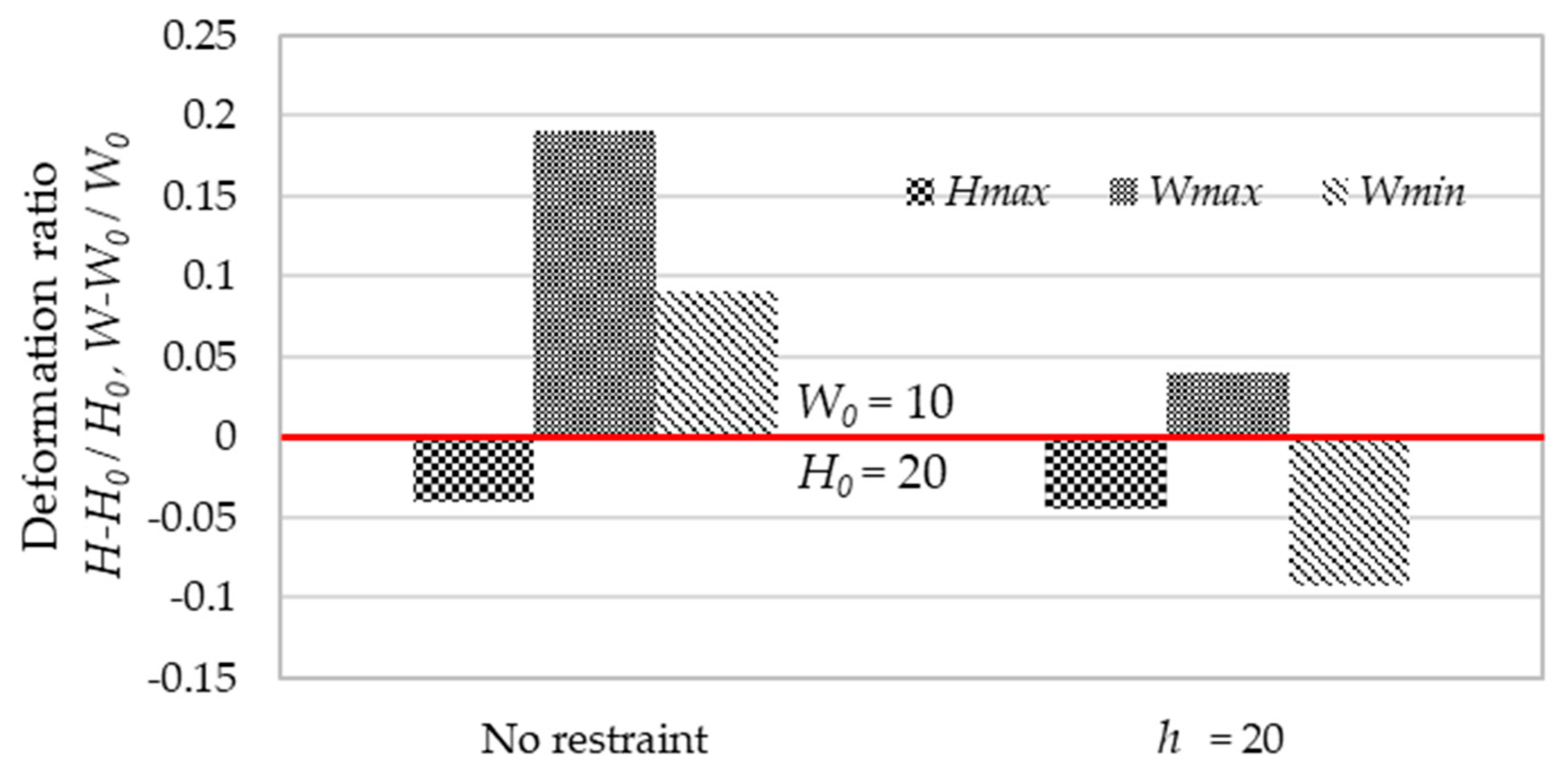
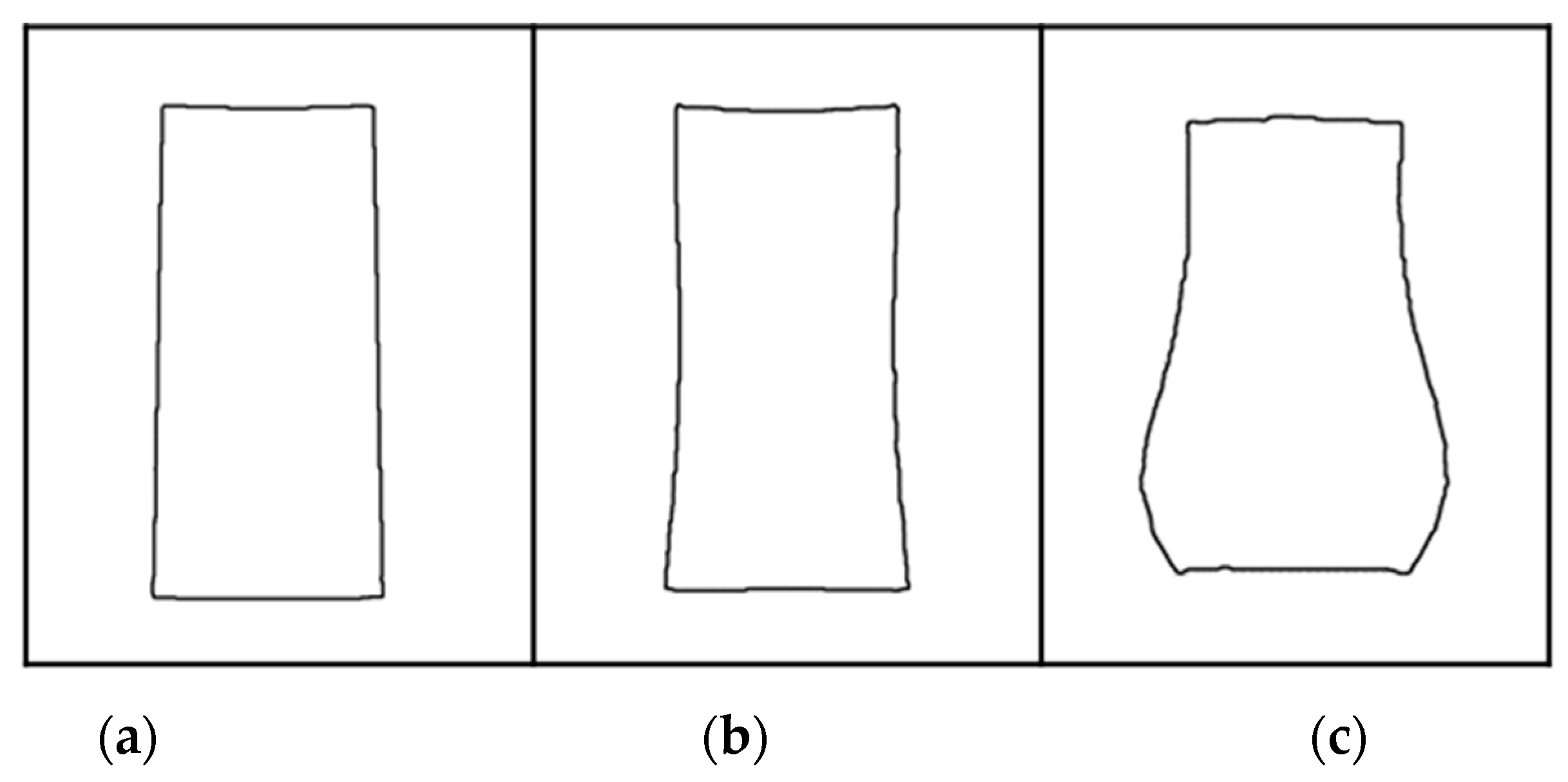
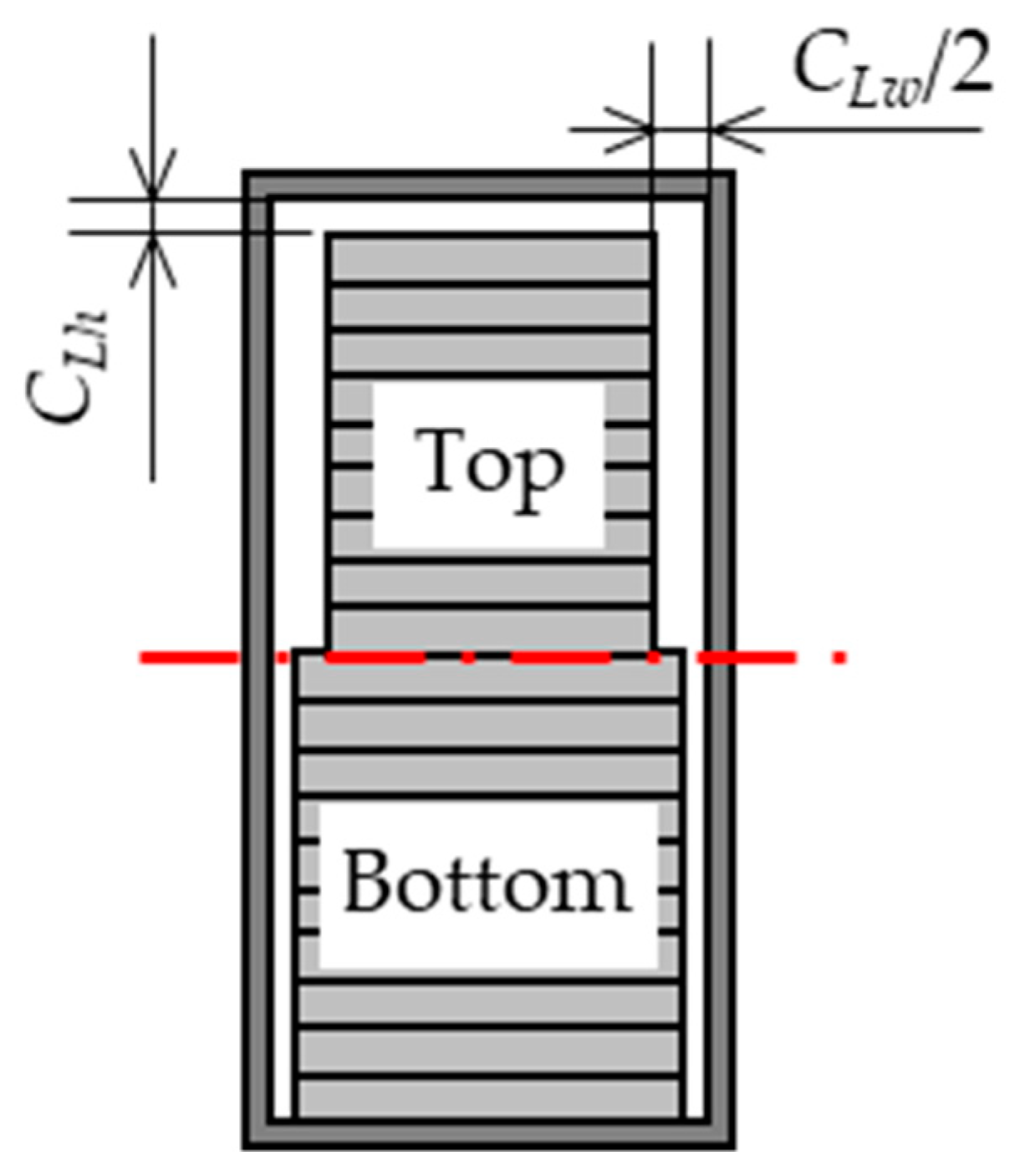

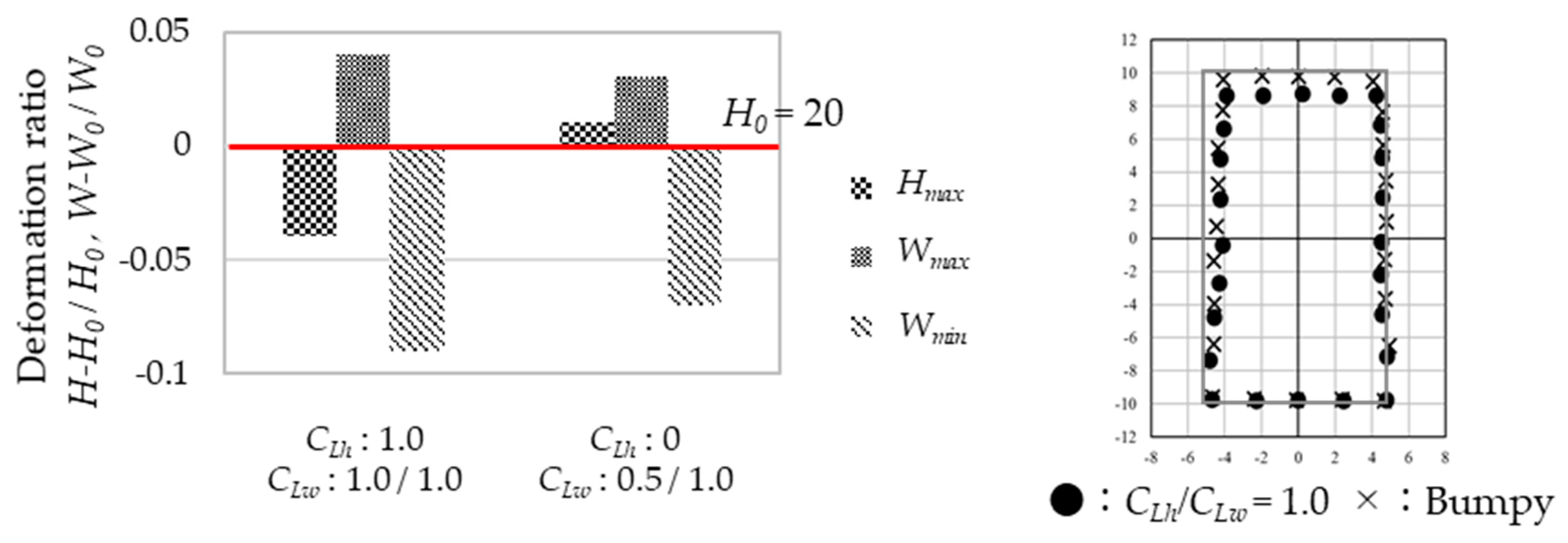
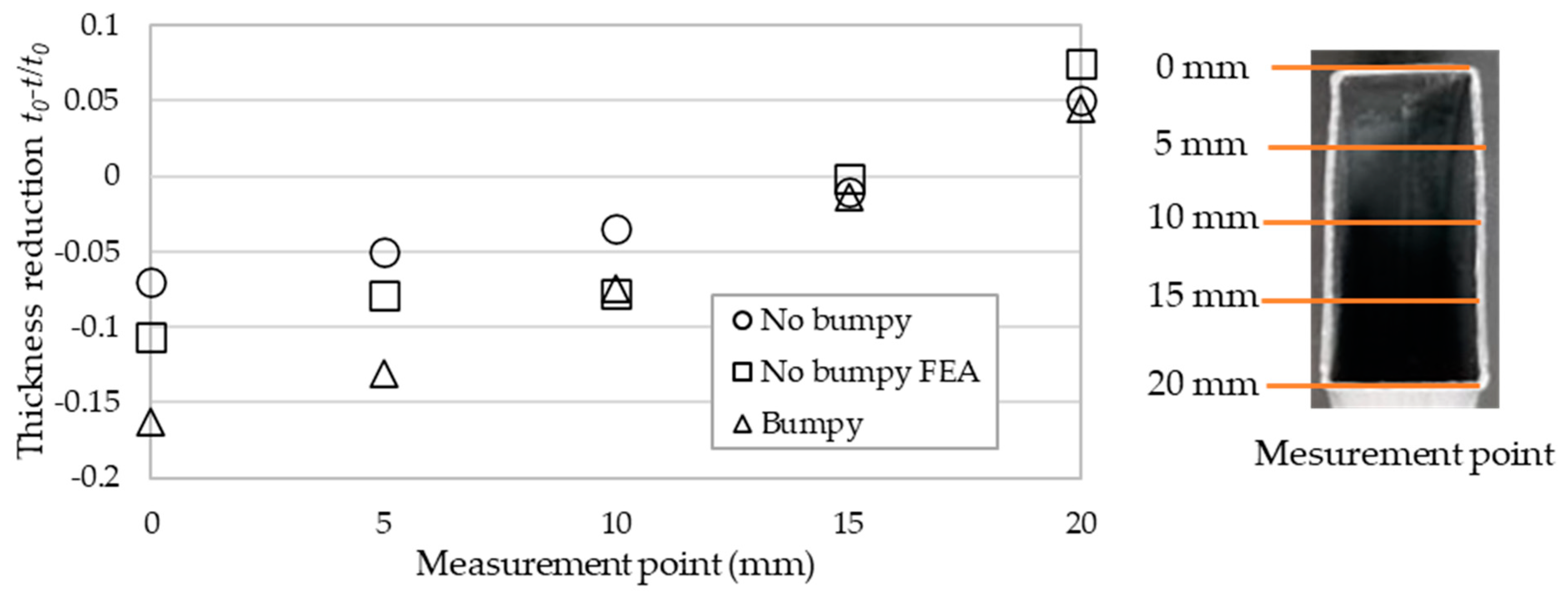
| A6063-O | |
|---|---|
| Tensile Strength σB/MPa | 91 |
| Proof Stress σ0.2/MPa | 39 |
| Elongation δ/% | 24.3 |
| Work-hardening Exponent n * | 0.27 |
| Plastic Modulus C */MPa | 160 |
| Workpiece | Mandrel | Bending Drum | Restraint Jig | Bar | |
|---|---|---|---|---|---|
| Element Type | Elasto-Plastic/Shell | Elastic/Solid | Rigid/Shell | Rigid/Shell | Rigid/Shell |
| Number of Elements | 17,250 | 1200 | 1515 | H0 = 10:1010 | 765 |
| H0 = 20:2020 | |||||
| Restraint condition | free | free * | 90° rotation | fixed | fixed |
| Height of Workpiece H0 | 20 mm | |||
| Bending drum radius R | 50 mm | |||
| Axial tension α | Apply | |||
| Height of restraint jigs h | 20 mm | |||
| Laminated Elastic Mandrel | Height CLh | 0.5 mm | 0 mm | 0 mm |
| Width CLw (Top/Bottom) | 0.5/0.5 mm | 0.5/0.5 mm | 1.0/0.5 mm | |
© 2020 by the authors. Licensee MDPI, Basel, Switzerland. This article is an open access article distributed under the terms and conditions of the Creative Commons Attribution (CC BY) license (http://creativecommons.org/licenses/by/4.0/).
Share and Cite
Nakajima, K.; Utsumi, N.; Saito, Y.; Yoshida, M. Deformation Property and Suppression of Ultra-Thin-Walled Rectangular Tube in Rotary Draw Bending. Metals 2020, 10, 1074. https://doi.org/10.3390/met10081074
Nakajima K, Utsumi N, Saito Y, Yoshida M. Deformation Property and Suppression of Ultra-Thin-Walled Rectangular Tube in Rotary Draw Bending. Metals. 2020; 10(8):1074. https://doi.org/10.3390/met10081074
Chicago/Turabian StyleNakajima, Kunito, Noah Utsumi, Yoshihisa Saito, and Masashi Yoshida. 2020. "Deformation Property and Suppression of Ultra-Thin-Walled Rectangular Tube in Rotary Draw Bending" Metals 10, no. 8: 1074. https://doi.org/10.3390/met10081074
APA StyleNakajima, K., Utsumi, N., Saito, Y., & Yoshida, M. (2020). Deformation Property and Suppression of Ultra-Thin-Walled Rectangular Tube in Rotary Draw Bending. Metals, 10(8), 1074. https://doi.org/10.3390/met10081074




